I thought I had fixed my noisy USB port issues when I added the iFi iDefender+ (powered from a separate USB charger) between my computer & my DAC. However a new noise has recently started coming through my speakers, this time a continuous high pitch (maybe ~1KHz?) rather than the previous noise that was related to mouse movement/screen activity. After a lot of frustrating troubleshooting I have discovered where I think the problem lies & could do with a fresh set of eyes trying to come up with a solution!
My DAC has RCA outputs on the back, which are connected to my amplifier for my speakers. The DAC also has a 1/4" TRS headphone output on the front. Both outputs are volume controlled via the knob on the front.
I noticed that the new high pitched noise was only playing through my speakers, not my headphones. So as an experiment, I connected both the RCA output & the heaphone output of the DAC to a small passive mixer (eg no power supply connected), so that I could easily listen to each output in turn through the speakers. This is the first picture; on the mixer, output is going to my amplifier, ch 3 input is coming from the DAC's RCA output on its rear, ch2 input is coming from the DAC's headphone output on its front. To my surprise, there was absolutely no trace of the high pitched noise in the speakers when listening to either input.
After some more experimenting, I discovered that the high pitched noise in the RCA output disappeared as long as the ground of the headphone output was connected to the ground of the mixer. When I disconnected the headphone output, as in the second picture, the high pitch noise came back through the speakers.
I did some more experiments. Just touching the ground of the headphone output to the ground of an input on the mixer was sufficient to remove the high pitch noise (third picture), likewise when just touching the ground of the headphone output to the RCA connector going to the amplifier (fourth picture).
However, when I removed the mixer, connected the DAC's RCA output directly to the amplifier & then touched the ground of the headphone output to the RCA output (fifth & sixth pictures) this did not remove the high pitch noise.
So, what exactly is happening when joining the grounds in the mixer (remembering that this is a passive mixer with no power supply), which isn't happening when joining the grounds at the DAC? With no cables connected there is continuity between all ground connections on the mixer. I even opened up the mixer (final two photos) looking for hints, but couldn't make heads or tails of it.
Essentially, why is the result of the fourth photo different to the result of the fifth/sixth photos?
Any ideas, please enlighten me - it's late & I'm thoroughly confused!
My DAC has RCA outputs on the back, which are connected to my amplifier for my speakers. The DAC also has a 1/4" TRS headphone output on the front. Both outputs are volume controlled via the knob on the front.
I noticed that the new high pitched noise was only playing through my speakers, not my headphones. So as an experiment, I connected both the RCA output & the heaphone output of the DAC to a small passive mixer (eg no power supply connected), so that I could easily listen to each output in turn through the speakers. This is the first picture; on the mixer, output is going to my amplifier, ch 3 input is coming from the DAC's RCA output on its rear, ch2 input is coming from the DAC's headphone output on its front. To my surprise, there was absolutely no trace of the high pitched noise in the speakers when listening to either input.
After some more experimenting, I discovered that the high pitched noise in the RCA output disappeared as long as the ground of the headphone output was connected to the ground of the mixer. When I disconnected the headphone output, as in the second picture, the high pitch noise came back through the speakers.
I did some more experiments. Just touching the ground of the headphone output to the ground of an input on the mixer was sufficient to remove the high pitch noise (third picture), likewise when just touching the ground of the headphone output to the RCA connector going to the amplifier (fourth picture).
However, when I removed the mixer, connected the DAC's RCA output directly to the amplifier & then touched the ground of the headphone output to the RCA output (fifth & sixth pictures) this did not remove the high pitch noise.
So, what exactly is happening when joining the grounds in the mixer (remembering that this is a passive mixer with no power supply), which isn't happening when joining the grounds at the DAC? With no cables connected there is continuity between all ground connections on the mixer. I even opened up the mixer (final two photos) looking for hints, but couldn't make heads or tails of it.
Essentially, why is the result of the fourth photo different to the result of the fifth/sixth photos?
Any ideas, please enlighten me - it's late & I'm thoroughly confused!
Attachments
-
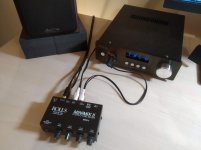 IMG_20200809_221457.jpg289 KB · Views: 175
IMG_20200809_221457.jpg289 KB · Views: 175 -
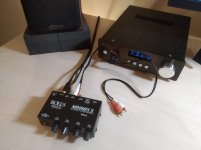 IMG_20200809_221515.jpg259.7 KB · Views: 171
IMG_20200809_221515.jpg259.7 KB · Views: 171 -
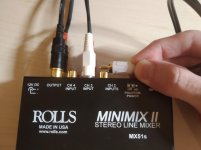 IMG_20200809_221535.jpg254.6 KB · Views: 167
IMG_20200809_221535.jpg254.6 KB · Views: 167 -
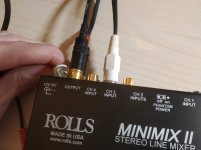 IMG_20200809_221603.jpg253.8 KB · Views: 165
IMG_20200809_221603.jpg253.8 KB · Views: 165 -
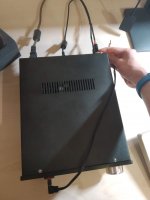 IMG_20200809_221723.jpg145 KB · Views: 168
IMG_20200809_221723.jpg145 KB · Views: 168 -
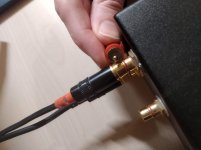 IMG_20200809_221751.jpg305.4 KB · Views: 57
IMG_20200809_221751.jpg305.4 KB · Views: 57 -
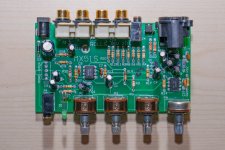 DSC04789.jpg591.2 KB · Views: 66
DSC04789.jpg591.2 KB · Views: 66 -
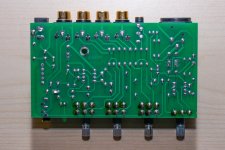 DSC04790.jpg440.1 KB · Views: 74
DSC04790.jpg440.1 KB · Views: 74
Last edited:
Everything is powered from the same AC outlet. I live in the UK where all our AC outlets are polarised. All of the device power connections (computer, DAC, amplifier, etc.) are also polarised (C13/C14 connectors). The iFi unit also breaks the computer's ground connection to the DAC via the USB cable.
Must be a ground loop, the laptop work on batteries. Try plugging both the PC and the DAC
into the same AC outlet. Also try reversing one or both AC plugs.
the desktop will be earthed and the laptop wont.
OP's setup is described here.
The 1 kHz signal - possibly USB packet noise - goes away when you add an additional ground connection in parallel to the audio cable between DAC and mixer. That should be a clue - obviously tighter ground bonding helps, as you would expect with an unbalanced system. USB isolation clearly is finite.
Two resolutions I can think of:
1. Use audio cables with substantially lower shield resistance.
2. Make proper use of the balanced inputs on the 223XL already, by either
a) making a custom adapter cable that uses shielded twisted pair cabling, with signal cold and shield being separated at the RCA (optional: impedance balancing for the cold line), or
b) involving a line isolator, or
c) using a DAC or audio interface with actual balanced outputs.
I hope the power amps have a balanced input (or are floating), otherwise I would expect more ground loop issues manifesting as increased distortion when the amplifier is loaded.
BTW - Audio-gd gear, as solid as it may look and feel, pretty much universally seems to give mediocre to downright poor measurements, indicating a "design by agenda" approach and actually poor electrical engineering.
The 1 kHz signal - possibly USB packet noise - goes away when you add an additional ground connection in parallel to the audio cable between DAC and mixer. That should be a clue - obviously tighter ground bonding helps, as you would expect with an unbalanced system. USB isolation clearly is finite.
Two resolutions I can think of:
1. Use audio cables with substantially lower shield resistance.
2. Make proper use of the balanced inputs on the 223XL already, by either
a) making a custom adapter cable that uses shielded twisted pair cabling, with signal cold and shield being separated at the RCA (optional: impedance balancing for the cold line), or
b) involving a line isolator, or
c) using a DAC or audio interface with actual balanced outputs.
I hope the power amps have a balanced input (or are floating), otherwise I would expect more ground loop issues manifesting as increased distortion when the amplifier is loaded.
BTW - Audio-gd gear, as solid as it may look and feel, pretty much universally seems to give mediocre to downright poor measurements, indicating a "design by agenda" approach and actually poor electrical engineering.
Last edited:
Swapping out the DAC for a Behringer UMC404HD with balanced outputs fixes the issue, at the cost of no longer having a decent headphone output or a nice big volume knob.
But I am still very confused, simply from an electrical standpoint, as to why the additional ground connection in parallel to the audio cable between DAC and mixer makes a difference - especially when joining the grounds directly at the DAC (which is all that the mixer is doing) has no effect?
But I am still very confused, simply from an electrical standpoint, as to why the additional ground connection in parallel to the audio cable between DAC and mixer makes a difference - especially when joining the grounds directly at the DAC (which is all that the mixer is doing) has no effect?
Not unexpectedly. Those are impedance-balanced btw.Swapping out the DAC for a Behringer UMC404HD with balanced outputs fixes the issue,
To be fair, the 404HD basically is just a 204HD with more I/Os, and that is a sub-$100 interface that actually still is pretty decent considering its rock-bottom price. If you need more oomph for headphones, you can always supercharge its headphone output with a JDS Labs Atom or something, or swap it out for the much better all-round performance of a MOTU M2 if your additional level needs aren't as substantial (about 2.95 Vrms into 600 ohms, according to Julian Krause's measurements).at the cost of no longer having a decent headphone output or a nice big volume knob.
AFAICT, it had no effect because at that point the connection wasn't located between the output and the crossover any more. If no currents are wanting to travel the shield, the drop will be zero no matter what.But I am still very confused, simply from an electrical standpoint, as to why the additional ground connection in parallel to the audio cable between DAC and mixer makes a difference - especially when joining the grounds directly at the DAC (which is all that the mixer is doing) has no effect?
If you need more oomph for headphones
The issue isn't the power, it's the sound. The actual DAC stage in the 404 is absolutely fine by my standards & listening to my speakers from its XLR main outputs doesn't sound perceptibly different (to me) than listening through the Audio-gd. In fact if anything, symbols/hats actually sound clearer on the 404.
However the headphone output of the 404 is a fairly drastic step down from that of the Audio-gd. I haven't really used headphones at my desk in a long time so it doesn't bother me enough to start looking at new kit right now, but the headphone output is definitely the downfall of what is otherwise a great unit in terms of price/performance/features. They also seem to have updated & improved the Windows 10 driver since I last used it, which is a nice surprise!
AFAICT, it had no effect because at that point the connection wasn't located between the output and the crossover any more. If no currents are wanting to travel the shield, the drop will be zero no matter what.
That makes some sense to me, I just didn't want to obsess over trying to puzzle out why the behaviour was different!
No surprises right there, these Behringers perform just fine assuming (a) you turn down the output level a tad to avoid saturating the analog stages near 0 dBFS (about -2.5 dB for the main out) and (b) you're content with little more than 800 mVrms and about 99 dB worth of dynamic range.The issue isn't the power, it's the sound. The actual DAC stage in the 404 is absolutely fine by my standards & listening to my speakers from its XLR main outputs doesn't sound perceptibly different (to me) than listening through the Audio-gd. In fact if anything, symbols/hats actually sound clearer on the 404.
People have stated that you can definitely run the headphone output into clipping, and recommended not to use headphone levels above ca. 1 o'clock (assuming you're actually hitting 0 dBFS, those like me with plenty of ReplayGain action can probably crank it some more). What sort of phones are you using? I would recommend something 80-300 ohm with decent sensitivity for full-sized cans, 32 ohms for in-ears. It's definitely not the worst headphone output you'll ever find - it maxes out at about a moderate 1.6 Vrms tops, output impedance is a moderately low 10 ohms, and distortion while driving 32 ohm loads at moderate levels is meh but still kind of acceptable. Never great but never terrible either. For comparison, the Steinberg UR22xx interfaces have an inexplicably high 90 ohm output impedance, and a few like the 3rd gen Focusrite Saffires bombed the 32 ohm distortion test quite spectacularly.However the headphone output of the 404 is a fairly drastic step down from that of the Audio-gd. I haven't really used headphones at my desk in a long time so it doesn't bother me enough to start looking at new kit right now, but the headphone output is definitely the downfall of what is otherwise a great unit in terms of price/performance/features. They also seem to have updated & improved the Windows 10 driver since I last used it, which is a nice surprise!
As I said, you can always run it into an external headphone amp if you really want, as long as that doesn't mind the ultrasonic hash.
- Status
- This old topic is closed. If you want to reopen this topic, contact a moderator using the "Report Post" button.
- Home
- Source & Line
- PC Based
- USB noise issue has gotten more bizarre